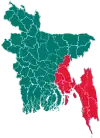Sandwip Upazila
Sandwip (Bengali: সন্দ্বীপ) is an upazila of Chittagong District in the Division of Chittagong, Bangladesh. It encompasses the islands of Sandwip and Urir Char.[1][2]
Sandwip
সন্দ্বীপ | |
|---|---|
 Sandwip Location in Bangladesh | |
| Coordinates: 22°29′N 91°26.5′E | |
| Country | |
| Division | Chittagong Division |
| District | Chittagong District |
| Capital | Sandwip Municipality |
| Upazila | 1984 |
| Government | |
| • MP (Chittagong-3) | Mahfuzur Rahaman Mita |
| • Upazila Chairman | Mohammad Shajahan |
| Area | |
| • Total | 762.42 km2 (294.37 sq mi) |
| Population (2011) | |
| • Total | 278,605 |
| • Density | 370/km2 (950/sq mi) |
| Time zone | UTC+6 (BST) |
| Website | http://sandwip.chittagong.gov.bd/ |
History
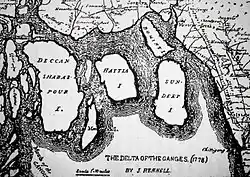
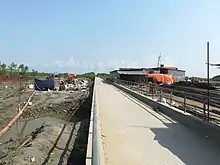
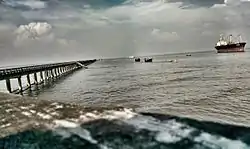
.jpg.webp)
Sandwip Island in Bangladesh has a great historical legacy. The island itself is about 3000 years old,[3] and was said to have been a part of the Samatata realm. It is supposed that Sandwip was connected with Chittagong original land and disconnected by natural disasters. Tansi reported on Lower Gangas (150) in which he included Sandwip. Sandwip is mentioned at The Baros Map (1560). Sanchan the Abevel mentioned Sandwip in his drawing map and he also mentioned Bhulua, Chittagong and Dhaka with it. The island is also found in The Anvel Curt's drawing map (1752). In 1923, Sri Rajkumar Chakrabarty mentioned in his History of Sandwip about the prevalence of 400 to 500 year old plants. Arab merchants began trading in the area since very early on.[4] In the 14th-century, a Sufi from Afghanistan called Sultan Balkhi visited the island and lived there for a few years.[5]
In the 16th century, the island became an important source of salt for Bengal.[lower-alpha 1] In the 1560s, a traveller from Venice called Caesar Frederick was the first European to write about Sandwip. Returning homeward from Pegu, he was caught in a typhoon whilst sailing from Chittagong to Cochin. After being tossed about for some days, his ship sighted an island and landed. He wrote:
"We found it a place inhabited, and, to my judgment, the fertilest island in all the world; the which is divided into two parts by a channel which passeth between it. With great trouble we brought our ship into the same channel, which parteth the island at flowing water."[6]:35
Frederick described the island as a densely-populated, well-cultivated island inhabited by Moors.
Early modern period
At the start of the 17th century, the island was under the rule of Antonio de Sousa Godinho, a Portuguese pirate, though it had previously been ruled by Kedar Rai, a Bengali Hindu chieftain who ruled over large parts of eastern Bengal. According to Pierre Du Jarric, Kedar Rai managed to retrieve Sandwip from Godinho with the help of another group of Portuguese pirates.[7] The Mughals and the Arakanese failed to annex Sandwip from Kedar Rai.[8][9][10] By 1602, a Portuguese settler from Montargil called Domingos Carvalho, who was in Kedar Rai's service, managed to earn the governorship of Sandwip after assisting him in battles against Arakan and the Mughals.[11] Emmanuel de Mattos came from Chittagong to aid Carvalho in the Portuguese annexation, and they divided the island between them and Gonçalves. Philippe de Brito also established a fort in the island. It is said that each year about 300 salt-loaded ships sailed from Sandwip for Liverpool. In addition to its salt industries, Sandwip became very famed for its ship-building as well at that time.[12] Thereafter, the Portuguese held the island in conjunction with the Arakanese and Muslim rulers. Even today some of the architecture on the island reflects this part of the island's history in which it was a 17th century pirate-stronghold. Philip III, the King of Portugal, ennobled Carvalho for his efforts.[7]
The loyalty of the Portuguese however, was suspected by the Arakanese. The Arakanese King of Mrauk U, Min Razagyi would execute many Portuguese settlers in his kingdom. In November 1602, the Jesuits fled to Sandwip following the imprisonment and death of their head chief Fernandez in Chittagong (which was under Arakanese rule). Carvalho fled to Jessore for safety, but its ruler Pratapaditya, was an ally of the Arakanese, and had him executed and sent his severed head back to Arakan.[13] Other sources say that Carvalho was not killed by Pratapaditya but was wounded in battle against the Mughals, and that as a result he fled to Hugli. Manuel de Matoo was his successor but the Portuguese were defeated in Sandwip during his office, and Fateh Khan took over the island.[7]
In March 1609, Sebastian Gonzales Tibao/Tibeau, who was an escapee of Arakanese punishment and a salt-dealer and soldier who had come to Bengal in 1605, led an army of 400 Portuguese mercenaries to colonise Sandwip, kill Fateh Khan and wipe out 3000 Muslim (non-Mughal) pirates and all of the island's male Muslim inhabitants.[7] He did this by negotiating a deal with the King of Bakla, receiving support such as ships and horses for the takeover, in exchange for half of the revenue of the island to be given to Bakla's king. However, Tibao withheld the agreed payment and warred with the King of Bakla too.[14] Razagyi was furious with the Portuguese movements, but he faced an even more urgent threat after hearing that the Mughal governor of Bengal was planning an attack on nearby Bhulua, and so he agreed to an alliance with Tibao.[15] Be that as it may, Tibao later broke the alliance, and seized the entire naval fleet by "the simple expedient of murdering its captains at a council".[6]:36 Tibao was described to have become the "absolute sovereign" of Sandwip, as he was even obeyed by the natives as an independent ruler. In the course of a short time, his territory extended to the up until the Lemro River and his forces consisted of 1000 Portuguese, 2000 Indian soldiers, 200 cavalry, and 80 sail of vessels of various sizes. Many merchants resorted to the island, and by their commerce contributed much to increase his revenue.[16] Tibao later took the islands of Shahbazpur and Patelbanga from the Raja of Batecala (Bacola). He was finally defeated in 1617, by Razagyi's son, Min Khamaung, who defeated Tibao in Sandwip, seized the island, reduced him to his former miserable condition and killed many inhabitants of the island.[14][17][18]
In the 1620s, Samuel Purchas also described the inhabitants as majority Mohammedans and mentioned the presence of a 300-year old mosque in the island. Abdul Hakim was a prominent medieval Bengali poet from Sandwip who was active in this period. As piracy was prevalent in the island for many decades, many people ruled over it such as Delwar Khan, also known as Raja Dilal, who was the final pirate ruler of Sandwip. A former Mughal officer, he and his private army ruled the island independently for about 50 years. In November 1665, Shaista Khan, the Mughal governor of Bengal, led a conquest to Sandwip with the support of the Dutch military, to defeat Dilwar who was 80-years old at the time.[19][20] The Arakanese had also fell out with the Portuguese, which led to the Portguese also assisting the Mughals. By 26 January 1666, the conquest was successful and the Chief Captain of the European pirates were rewarded.[7] Dilwar was successively locked up in an iron cage in Murshidabad.[21] The volume of shipbuilding swelled extensively during the Mughal period. During the 17th century, the shipyards of Sandwip used to build warships for the Ottoman caliphs.[22][23]
In the late 18th century to early 19th century, Armenian merchants began to do business here. Khojah Kaworke, Khojah Michael and Agha Barshick owned several salt farms in Sandwip and the existent of such factories were also noted by Italian traveller Niccolao Manucci.[24][25]
Modern period
By the time the island came under British rule, it had a mixed population of Bengalis, both Muslim and Hindu, many of whom had arrived from Dhaka, as well as the Buddhist Arakanese. The working population consisted of farmers, fishermen, pirates and robbers. The British initially struggled in administrating the island as its inhabitants used to frequently make complaints. They eventually appointed a Commissioner but he too would complain of the difficulties in managing the island with constant petitions of the Taluqdars. Abu Torab, a descendant of Chand Khan who was the son-in-law of Raja Dilal, led Bengal's first anti-British peasant rebellion against Captain Nollekins in 1767. As a result of troublesome administration, the island was subsequently given direct attention to the District Collector in 1785. In 1822, the island joined the District of Noakhali.[21] In 1912, many Muslim men from Sandwip travelled to the Balkan Peninsula to fight alongside the Ottoman Empire during the Balkan Wars. Keshab Ghosh, a President of the Indian National Congress, led the Violation of Law movement in Sandwip in 1930.[26]
It is said that Sheikh Mujibur Rahman's 1966 Six point movement began in Sandwip. During the 1970 Pakistani general election campaign, Mohammad Shah Bangali of Sandwip was the folk singer mascot for the Awami League.[26] The area was heavily affected during the 1970 Bhola cyclone and as a response, the Government of Pakistan sent three gunboats and a hospital ship carrying medical personnel and supplies.[27] The Government of Singapore sent a military medical mission to the country, which was then deployed to Sandwip where they treated nearly 27,000 people and carried out a smallpox vaccination effort.[28] During the Bangladesh Liberation War of 1971, Sandwip was included in Sector 1. On 10 May, many civilians were murdered including Jahedur Rahman, a lawyer in Sandwip town killed in Kargil Bridge. On the same day, Jasim Uddin, a student at the Chittagong College, was arrested in Sandwip and taken to Chittagong to be imprisoned. He was later released but continued as a Bengali freedom fighter, leading to his execution on 10 December.[26]
Around 1970/1971, an island emerged just northwest of Sandwip near the Meghna Estuary. A few days after its emergence, Sandwip's residents began to explore the new island and found that there was a type of grass colloquially known as Uri in abundance across the island. Due to this, the island became known as Urir Char which means the river island of Uri. Through the initiative of Asadul Haq Chowdhury (Prakash Saheb Miah), the erstwhile chairman of Kalapania Union, some landless people of Sandwip Island (whose homes had been lost due to diluvium) were relocated to Urirchar between 1980 and 1981.[29]
In 1984, Sandwip Thana's status was upgraded to upazila (sub-district level). The construction works of a Bangladesh Navy fleet headquarters at the Sandwip Channel with ship berthing facilities is also going on as part of the Forces Goal 2030.[30] In 2010, the Government of Bangladesh announced a plan to build a dam in Urir Char to reclaim land as it had suffered greatly from Tropical Storm One and the 1991 Bangladesh cyclone among other natural disasters.[31]
Geography
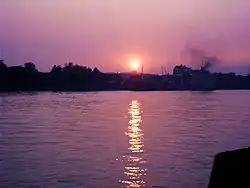
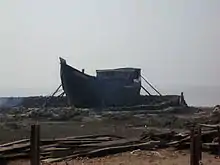
Sandwip is located at 22.4833°N 91.4417°E. It has a total area of 762.42 km2.[1]
Demographics
According to the 1991 Bangladesh census, Sandwip had a population of 272,179. Males constituted 49.68% of the population, and females 50.32%. The population aged 18 or over was 122,499. Sandwip had an average literacy rate of 35% (7+ years), against the national average of 32.4%.[32]
Sandwip has 45, 389 households.[33]
Administration
Sandwip Upazila is divided into the Sandwip Municipality and 15 union parishads: Amanullah, Azimpur, Bauria, Digghapar, Gachhua, Haramia, Harispur, Kalapania, Magdhara, Maitbhanga, Musapur, Rahmatpur, Santoshpur, Sarikait, and Urirchar. The union parishads are subdivided into 39 mouzas and 34 villages.[34]
Sandwip Municipality is subdivided into 9 wards and 10 mahallas.[34]
List of chairmen and rulers
| Name | Notes |
|---|---|
| Muhammad Rafiqullah Chowdhury | |
| Mustafa Kamal Pasha | |
| Mohammad Shajahan | Present |
Education
There are 28 secondary schools in Sandwip Upazila. Some these include:
- Kargil Government High School, the oldest school in the Upazila founded in 1879
- Gachua Adarsha High School, established in 1987
- Bauria Golam Khalek Academy
In total, the upazila has 149 state primary schools, one junior high school, 4 colleges, 1 girls college, 19 kindergartens and 3 girls high schools. There are 9 dakhil madrasas, 3 alim madrasas, 3 fazil madrasas and four Kamil madrasas. Notable madrasas include the Bashiria Ahmadia Alhaj Abu Bakar Sidiqque Fazil Madrasa, founded in 1902, and the Kathgar Islamia Fazil Madrasa which was founded in 1929. The upazila has a literacy rate of 51.5%.
Facilities
The upazila is home to 10 orphanages, including one governmental orphanage. It also has 295 mosques which serve the majority Sunni Muslim population that inhabit the sub-district. Some notable mosques include the Shahabanu Mosque, Faqir Shah mosque, the Sandwip Town Jame Mosque, Sandwip Town Bazar Mosque and the Abdul Ghani Chowdhury Mosque. There are 32 haat bazaars and two canals. 26 post offices and 10 banks can also be found here.
Notable people
- Wajihullah, 20th-century Islamic scholar
- Abul Kashem Sandwip, educationist and a founder of Bangladesh Betar
- Abdul Haq
- Abdul Hakim, 17th-century poet
- Abul Fazal Ziaur Rahman, physician and army officer
- AKM Asadul Haq, physician and army officer
- AKM Rafiq Ullah Choudhury, politician and language activist
- Alhaz Mustafizur Rahman, politician
- Belal Muhammad, a founder of Swadhin Bangla Betar Kendra
- Belayet Hossain, Bangladeshi freedom fighter
- Chowdhury Hasan Sarwardy, former lieutenant general of the Bangladesh Army
- Mahfuzur Rahaman, politician
- M. Obaidul Huq, politician
- Mostafa Kamal Pasha, politician
- Muzaffar Ahmad, politician and journalist
- Mohammed Didarul Alam
- Lalmohan Sen, revolutionary involved in the Chittagong armoury raid
- Mohit Kamal, psychotherapist
Notes
- "Sandwip is evidently a very old island, and seems to have been of more importance three hundred years ago than it is now [mid-1800s], because it was one of the chief sources from which Bengal was supplied with salt." "Du Jarric ... tells us that it is opposite Sripur, and that it supplies all Bengal with salt."[6]:35,36
References
- Chowdhury, Towhid Hossain (2012). "Sandwip Upazila". In Islam, Sirajul; Miah, Sajahan; Khanam, Mahfuza; Ahmed, Sabbir (eds.). Banglapedia: the National Encyclopedia of Bangladesh (Online ed.). Dhaka, Bangladesh: Banglapedia Trust, Asiatic Society of Bangladesh. ISBN 984-32-0576-6. OCLC 52727562. Retrieved 31 January 2021.
- District in Focus: Chittagong
- Noakhali District Gazetters
- Muslehuddin, ATM (2012). "Arabic". In Islam, Sirajul; Miah, Sajahan; Khanam, Mahfuza; Ahmed, Sabbir (eds.). Banglapedia: the National Encyclopedia of Bangladesh (Online ed.). Dhaka, Bangladesh: Banglapedia Trust, Asiatic Society of Bangladesh. ISBN 984-32-0576-6. OCLC 52727562. Retrieved 31 January 2021.
- Abdul Karim (2012). "Shah Sultan Mahisawar (R)". In Islam, Sirajul; Miah, Sajahan; Khanam, Mahfuza; Ahmed, Sabbir (eds.). Banglapedia: the National Encyclopedia of Bangladesh (Online ed.). Dhaka, Bangladesh: Banglapedia Trust, Asiatic Society of Bangladesh. ISBN 984-32-0576-6. OCLC 52727562. Retrieved 31 January 2021.
- Beveridge, Henry (1876). The district of Bákarganj; its history and statistics. London: Trübner & Co.
- Ray, Aniruddha (2012). "Portuguese, The". In Islam, Sirajul; Miah, Sajahan; Khanam, Mahfuza; Ahmed, Sabbir (eds.). Banglapedia: the National Encyclopedia of Bangladesh (Online ed.). Dhaka, Bangladesh: Banglapedia Trust, Asiatic Society of Bangladesh. ISBN 984-32-0576-6. OCLC 52727562. Retrieved 31 January 2021.
- পাতা:ঐতিহাসিক চিত্র (তৃতীয় বর্ষ) - নিখিলনাথ রায়.pdf/২২ - উইকিসংকলন একটি মুক্ত পাঠাগার. bn.wikisource.org. Retrieved 2019-03-05.
- কেদার রায়. Bangladesher Khabor | Latest News, Breaking News, Sports, Entertainment, Politics, Business, Videos & Photos (in Bengali). Retrieved 2019-03-04.
- পাতা:প্রতাপাদিত্য-নিখিল নাথ রায়.djvu/৭৩ - উইকিসংকলন একটি মুক্ত পাঠাগার. bn.wikisource.org. Retrieved 2019-03-05.
- Mandal, Asim Kumar (2003). The Sundarbans of India : a development analysis. New Delhi: Indus Publ. Co. p. 44. ISBN 8173871434. Retrieved 28 June 2015.
- Editorial. "Sandwipees should respond to the call of Master Shahjahan for development of Sandwip". The Guardian. Retrieved 12 July 2015.
- Beveridge, Henry (1876). The district of Bákarganj; its history and statistics. London: Trübner & Co. pp. 173–179.
- Manuel de Faria y Sousa, Asia Portuguesa, 1666. English translation 1695 by Captain John Stevens, quoted by Beveridge 1876, p. 37.
- (Sandamala Linkara Vol. 2 1999: 84): Tuesday, 4th waxing of Natdaw 971 ME = 1 December 1609
- Stewart, History of Bengal, quoted in Beveridge, 1876, p. 36.
- Phayre 1967: 174–177
- Harvey 1925: 142–143
- Abdul Karim (2012). "Shaista Khan". In Islam, Sirajul; Miah, Sajahan; Khanam, Mahfuza; Ahmed, Sabbir (eds.). Banglapedia: the National Encyclopedia of Bangladesh (Online ed.). Dhaka, Bangladesh: Banglapedia Trust, Asiatic Society of Bangladesh. ISBN 984-32-0576-6. OCLC 52727562. Retrieved 31 January 2021.
- Sarkar, Jadunath, ed. (1973) [First published 1948]. The History of Bengal. Volume II: Muslim Period, 1200–1757. Patna: Academica Asiatica. p. 379. OCLC 924890.
It was Shāista Khan's task to put an end to this terror [the Arakan pirates] ... The Bengal flotilla (nawwāra) had been wofully depleted ... Shāista Khan's energy and persistence overcame every obstacle. A new navy was created, manned and equipped in a little over a year ... In a short time 300 vessels were ... ready in war-trim ... The island of Sondip ... [was] captured ... (November 1665.) A still more important gain was the seduction of the Feringis of Chātgāon from the side of the Arakanese ... A feud had just then broken out between the Magh ruler of Chātgāon and the local Portuguese ... Shāista Khan gave their chief captain a bounty ... and their other leaders were all enlisted in the Mughal service.
- George Abraham Grierson. "Sandip, Noakhali District". Linguistic Survey of India. V Pt 1. pp. 247-.
- Islam, Sirajul; Miah, Sajahan; Khanam, Mahfuza; Ahmed, Sabbir, eds. (2012). "Shipbuilding Industry". Banglapedia: the National Encyclopedia of Bangladesh (Online ed.). Dhaka, Bangladesh: Banglapedia Trust, Asiatic Society of Bangladesh. ISBN 984-32-0576-6. OCLC 52727562. Retrieved 31 January 2021.
- "Prospects of shipbuilding industry in Bangladesh". Archived from the original on 2013-12-17. Retrieved 2015-07-30.
- Ray, Aniruddha (2012). "Manucci, Niccolao". In Islam, Sirajul; Miah, Sajahan; Khanam, Mahfuza; Ahmed, Sabbir (eds.). Banglapedia: the National Encyclopedia of Bangladesh (Online ed.). Dhaka, Bangladesh: Banglapedia Trust, Asiatic Society of Bangladesh. ISBN 984-32-0576-6. OCLC 52727562. Retrieved 31 January 2021.
- Ansar Ali, Sushil Chaudhury & Sirajul Islam (2012). "Armenians, The". In Islam, Sirajul; Miah, Sajahan; Khanam, Mahfuza; Ahmed, Sabbir (eds.). Banglapedia: the National Encyclopedia of Bangladesh (Online ed.). Dhaka, Bangladesh: Banglapedia Trust, Asiatic Society of Bangladesh. ISBN 984-32-0576-6. OCLC 52727562. Retrieved 31 January 2021.
- Abul Kalam Elias (16 December 2003). "The contribution of Sandwip to the struggle for freedom". The Daily Star. 4.
- "Thousands of Pakistanis Are Killed by Tidal Wave". The New York Times. November 14, 1970.
- Choy Choi Kee (November 7, 1999). "Medical Mission to East Pakistan". Ministry of Defence. Archived from the original on June 26, 2007. Retrieved April 15, 2007.
- "উড়ির চর ইউনিয়নের ইতিহাস" [Urir Char Union's History]. Urirchor Iuniyon (in Bengali).
- "One day BD Navy to become builder from buyer, hopes PM". UNB. 24 December 2017. Archived from the original on 25 December 2017. Retrieved 24 December 2017.
- "Project to recover land of Urir Char". banglanews24.com. 31 August 2010. Retrieved 9 February 2019.
- "Population Census Wing, BBS". Archived from the original on 2005-03-27. Retrieved November 10, 2006.
- http://www.lged.gov.bd/DistrictArea2.aspx?Area=UnionParishad&DistrictID=11
- "District Statistics 2011: Chittagong" (PDF). Bangladesh Bureau of Statistics. Archived from the original (PDF) on 13 November 2014. Retrieved 14 July 2014.
